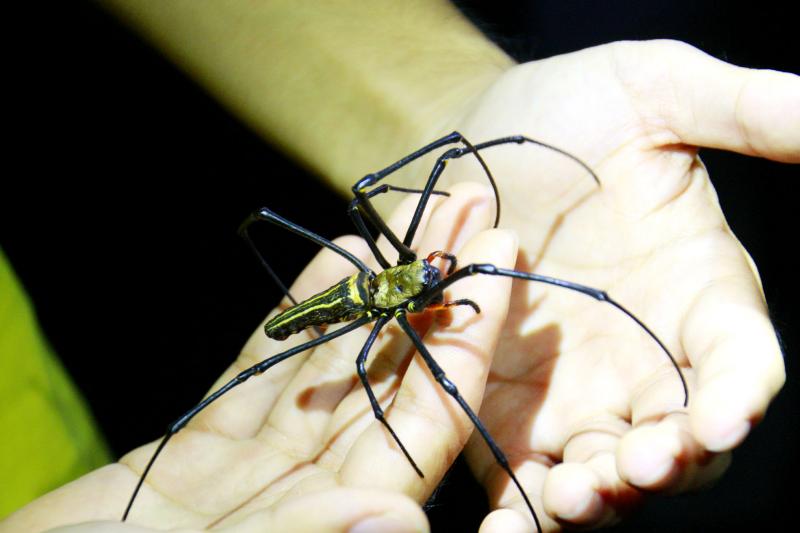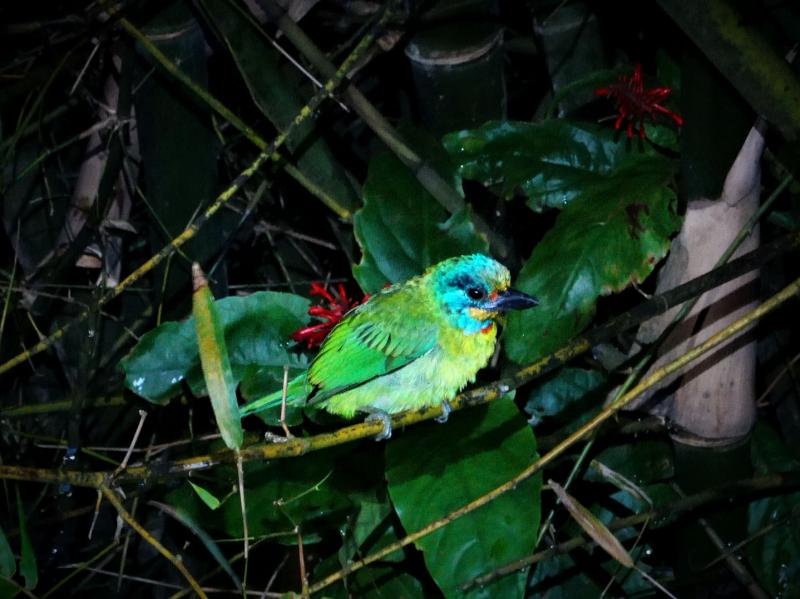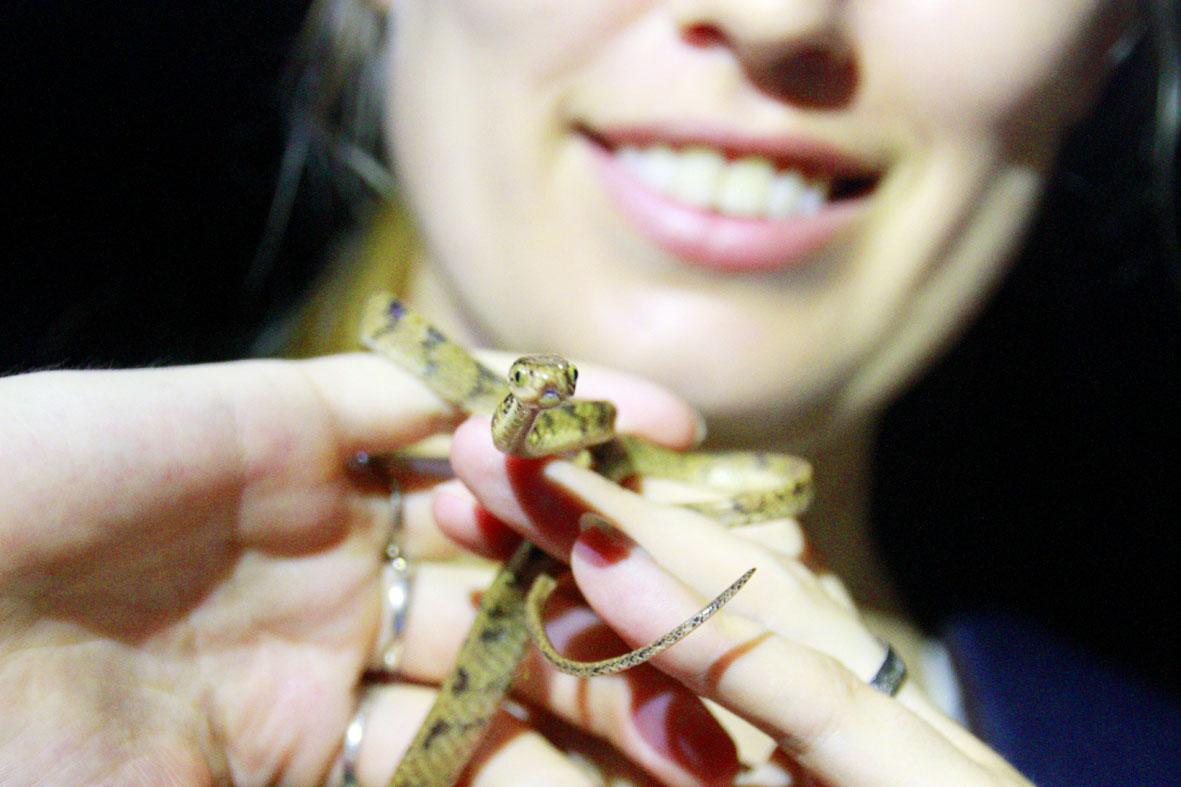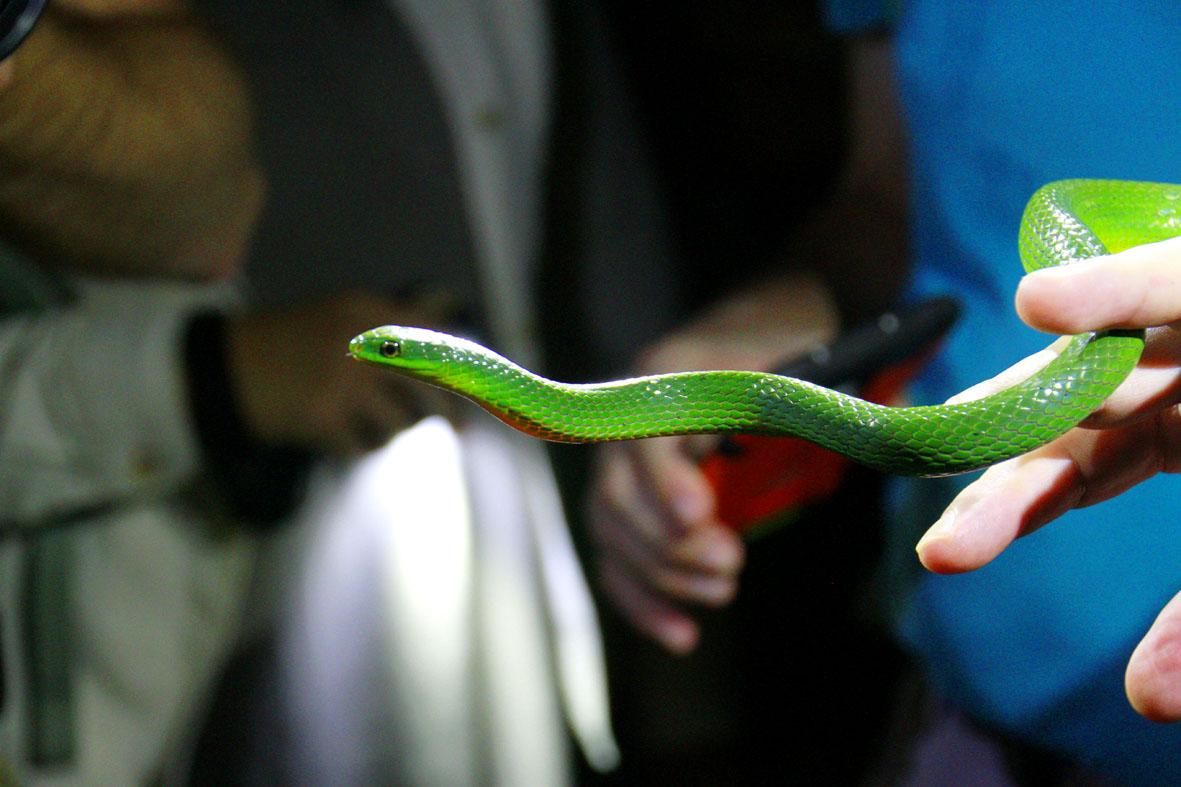“Oh my gosh,” exclaims one of our hiking party as an enormous giant golden orbweaver (Nephila pilipes) crawls up the face of another, its leg-span wider than the palm of his hand.
These large gold and black spiders are commonly seen at the side of Taipei’s mountain trails, sometimes even crossing the entire trail. Many have had the unpleasant experience of walking face-first into one of their webs, but having one crawl over your face may be a bit much for most.
Starting at the China University of Science and Technology (中華科技大學), we soon discover stage six of the 92km Taipei Grand Trail (台北大縱走) is alive with these spiders, along with an abundance of other biodiversity, even as it passes through the heart of Taipei.

Photo courtesy of Candy Huang
This roughly 10km stretch of trail also boasts some world famous views of Taipei 101, as it climbs the Four Beasts Ridge (四獸山) and Thumb Range (拇指山). It intersects with Tiger (虎山), Elephant (象山), Leopard (豹山) and Lion (獅山) mountains trails, before ending at Fuzhoushan (福州山) and Fuyang Eco-park (富陽自然生態公園).
LIFE ON THE TRAIL
As soon as we start, we find some sleeping grass lizards, and next to them a temple tree frog (Kurixalus idiootocus). Various frogs sit around in trees and along the sides of a small stream. We pass by a small green tree viper (Trimeresurus stejnegeri) resting up in the foliage, slightly too high for a close look.

Photo: James Osborne
Moments later we find a greater green snake (Ptyas major) sleeping in a shrub. These non-venomous snakes have been by far the most common snake we have encountered along the trail so far.
It is best to avoid handling wildlife, but with so many of our group on their first night hike tonight, having a closer look is such a good educational opportunity. We carefully bring it down and let it crawl from arm to arm. These are docile snakes, and will remain quite relaxed if not gripped. It is always good to showcase how peaceful snakes can be.
We meander up the gentle incline of the stone walkway to the sounds of owls and tree frogs. Despite the close proximity of downtown Taipei, the sounds of the city are muted by the dense forest. An owl swoops from a tree above our heads as we pass a small Buddhist shrine in the hollow of a tree.

Photo courtesy of Candy Huang
Here we spot the giant golden orbweaver. Of course it draws everyone’s awe and attention. Janus, an entomology student with us, reaches down to its web, and gently allows the spider to crawl up onto his arm. Naturally the group lets out some exclamations of shock. But he assures us that they are harmless, and only bite if you are rough with them. To illustrate his point, he allows it to crawl over his face. He then places it back on its web.
“We’ve got a slug-snake,” someone shouts as I’m trying to film another green tree viper. The night is off to a great start already. We crowd around for a closer look at Taiwan’s cutest and most docile snake, the Formosa slug snake (Pareas formosensis). As the name suggests, these snakes feed exclusively on slugs and snails. It is a treat to find one. Although they are common, it is the first we have found on the Grand Taipei Trail so far.
Further up the trail a venomous Taiwanese habu (Protobothrops mucrosquamatus) is slithering across the path. Contrary to slug snakes, these can be dangerous. But left alone they are no threat to anyone.

Photo courtesy of Candy Huang
A couple snakes clamber in the trees overhead as we approach the ridge-top. From here we get some amazing views right down over Taipei 101 and the heart of Taipei. After a few photos, our team is ready to move on and see more of the real splendor of the trail; it’s amazing creatures.
We are not disappointed, as sleeping beside the ridge top trail is a beautiful Taiwan barbet (Psilopogon nuchalis), also known in Chinese as the “five-color bird” (五色鳥) due to its many colors. Brilliant green, with patches of red, orange, yellow and blue around their faces, these birds are the jewels of Taiwan. Although common, they tend to be hard to see high in the tree-tops. We are lucky to get a close look at one on its sleeping perch so close to the trail.
Before the highest peak, we get an up close look at a flying squirrel munching on leaves in a trail-side tree. Again, this is an exciting first-time encounter for many in our group. We leave it to its dinner and continue on up and over the summit.
CEMETERIES
As we reach the junction at the top of Elephant Mountain it is almost midnight. Due to favorable weather conditions, we’ve decided to do stage six on a Wednesday, so many of our team must work in the morning. As such our party splits with half of the group taking the shorter descent back down the Elephant Mountain (象山) trail. Five of us continue on.
The remainder of the ridge down is full of life too. A green tree viper sits in ambush atop the leaves of an elephant’s ear (Colocasia). Another greater green snake sleeps in a tree, and then we soon walk by another. High in a tree, a cat snake (Boiga kraepelini) makes its way from one branch to another.
The trail soon drops down and emerges in a small suburb of Taipei City. The final couple of kilometers of stage six combine segments of forest trails, temples, farms and roads, as well as a section of road through a cemetery. It is approaching 2am, so we pick up the pace as we navigate the network of paths that make up the Fuzhoushan (福州山) area.
We stop at the peak to soak in some more views. The city-scape is darker now with Taipei 101’s lights turned off. Climbing on the beams of an abandoned rest shelter at the peak, someone spots something. “James, you should come check this out.” Yet another green tree viper is climbing around on some old wires. It’s fascinating to see a jewel of nature interacting with the derelict human structure.
From here we continue at quite a pace down to Fuyang Eco-park and finish the hike. A 10km hike is more than enough for a weeknight after work. At close to 3am, we are pretty keen to get home to bed.
James Osborne spends a lot of his time exploring Taiwan’s abundant biodiversity. Recently his focus has been to film the Taipei Grand Trail at night, and share all the nocturnal wildlife discoveries. Check out his YouTube channel (James Osborne) for these videos and other ecological adventures.

Earlier this month Economic Affairs Minister Kuo Jyh-huei (郭智輝) proposed buying green power from the Philippines and shipping it to Taiwan, in remarks made during a legislative hearing. Because this is an eminently reasonable and useful proposal, it was immediately criticized by the Chinese Nationalist Party (KMT) and Taiwan People’s Party (TPP). KMT Legislator Chang Chia-chun (張嘉郡) said that Taiwan pays NT$40 billion annually to fix cables, while TPP heavyweight Huang Kuo-chang (黃國昌) complained that Kuo wanted to draw public attention away from Taiwan’s renewable energy ratio. Considering the legal troubles currently inundating the TPP, one would think Huang would

Taipei Mayor Chiang Wan-an (將萬安) last week told residents to avoid wearing scary Halloween costumes on the MRT so as not to alarm other passengers. Well, I thought, so much for my plan to visit Taipei dressed as the National Development Council’s (NDC) biennial population report “Population Projections for the Republic of China (Taiwan): 2024-2070,” which came out last week. Terms like “low birth rate” and “demographic decline” do not cut it — the report is nothing short of a demographic disaster. Yet, in Taiwan, as in other countries, it is solvable. It simply requires a change in mindset. As it

One of BaLiwakes’ best known songs, Penanwang (Puyuma King), contains Puyuma-language lyrics written in Japanese syllabaries, set to the tune of Stephen Foster’s Old Black Joe. Penned around 1964, the words praise the Qing Dynasty-era indigenous leader Paliday not for his heroic deeds, but his willingness to adopt higher-yield Han farming practices and build new roads connecting to the outside world. “BaLiwakes lived through several upheavals in regime, language and environment. It truly required the courage and wisdom of the Puyuma King in order to maintain his ties to his traditions while facing the future,” writes Tsai Pei-han (蔡佩含) in

Chiayi County is blessed with several worthwhile upland trails, not all of which I’ve hiked. A few weeks ago, I finally got around to tackling Tanghu Historic Trail (塘湖古道), a short but unusually steep route in Jhuci Township (竹崎). According to the Web site of the Alishan National Scenic Area (阿里山國家風景區), the path climbs from 308m above sea level to an elevation of 770m in just 1.58km, an average gradient of 29 percent. And unless you arrange for someone to bring you to the starting point and collect you at the other end, there’s no way to avoid a significant amount